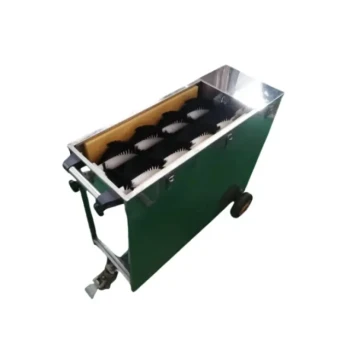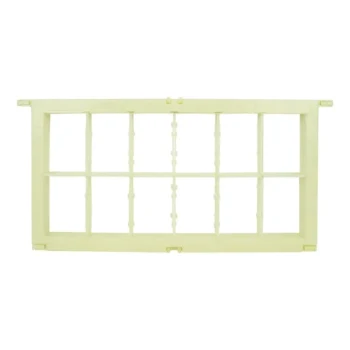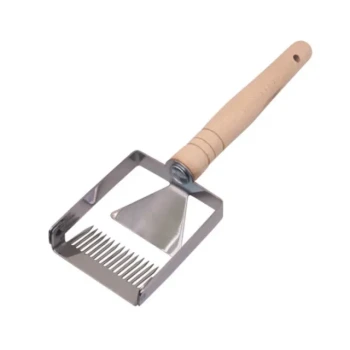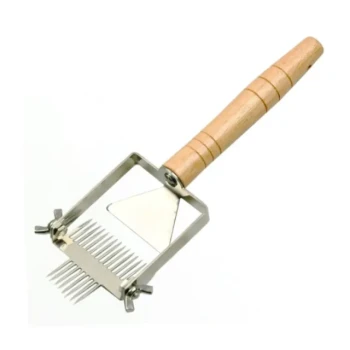At its core, a Flow Hive works by using specially designed plastic frames that allow for honey extraction without opening the hive. These frames contain pre-formed hexagonal cells that are split vertically. When a tool is inserted and turned, the two halves of the cells shift, breaking the wax capping and creating channels for pure, unprocessed honey to flow directly out of a tap via gravity.
The central innovation of the Flow Hive is not that it changes beekeeping, but that it changes honey harvesting. It replaces a disruptive, labor-intensive process with a gentle, gravity-fed system, though it does not eliminate the fundamental responsibilities of hive management.
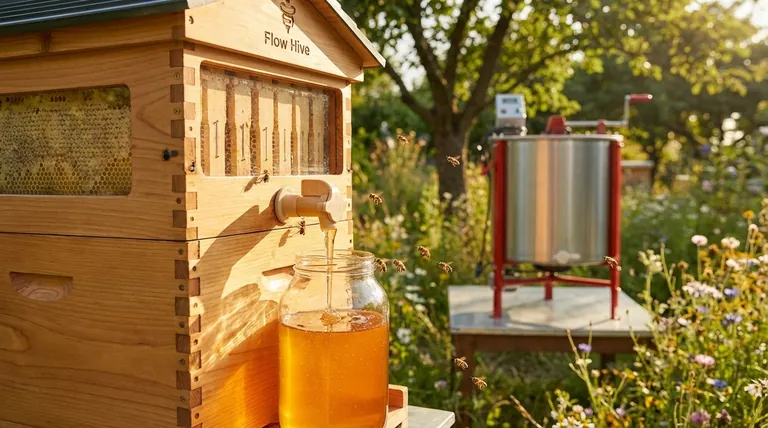
The Mechanics of a Flow Frame
A Flow Hive looks very similar to a traditional Langstroth hive from the outside. The revolutionary technology is contained entirely within the honey storage boxes, known as "supers."
The 'Split Cell' Design
The system relies on injection-moulded, food-grade plastic frames. These frames serve as a foundation that is made of partially formed honeycomb cells.
Critically, each cell is formed in two vertical halves. This creates a "split" down the middle that is almost invisible when the frame is in its "cell-forming" position.
The Role of the Bees
Bees treat the plastic foundation much like a traditional wax foundation. They complete the cells with their own wax, fill them with nectar, dehydrate it into honey, and then cap the cells with a final layer of wax once the honey is ready.
From the bees' perspective, their job of producing and storing honey remains exactly the same.
The Extraction Process
Once the beekeeper can see that the bees have capped the cells, harvesting can begin.
A special metal key is inserted into the top of the frame. Turning this key 90 degrees moves a mechanism that shifts one half of the split cells vertically relative to the other.
This movement breaks the wax seal on every cell simultaneously and creates continuous, descending channels through the comb. Gravity then takes over, and the honey flows down these channels into a trough at the base of the frame and out a spout into your collection jar.
Key Advantages of the Flow System
The design's primary goal is to make honey harvesting less stressful for both the bees and the beekeeper.
Reduced Stress on Bees
Traditional harvesting requires opening the hive, smoking the bees, removing heavy frames, and transporting them to a processing area.
The Flow system eliminates this disruption entirely. The hive remains sealed and calm, and the bees are left largely undisturbed to clean up the empty cells and begin refilling them.
Simplified for the Beekeeper
For the beekeeper, this design removes the need for expensive and cumbersome extraction equipment like uncapping knives and centrifuges.
The process is far less labor-intensive and physically demanding. It transforms harvesting from a multi-hour, sticky job into a simple process of turning a key and watching honey flow.
Purity of the Honey
Because the honey flows directly from the comb into a sealed container, it is exceptionally clean and pure. It is never exposed to the air or processing equipment until it's in the final jar, preserving its delicate flavors and aromas.
Understanding the Trade-offs and Responsibilities
While the honey extraction is simplified, a Flow Hive does not create a "set-and-forget" beekeeping experience. Understanding its limitations is critical for success.
The Myth of 'No-Maintenance' Beekeeping
A Flow Hive is simply a brand of beehive. It does not protect bees from pests or diseases.
You must still perform regular hive inspections to check for the health of the queen, the brood pattern, and common threats like the Varroa mite. This essential stewardship is unchanged.
Material and Cost Considerations
Flow Hives represent a significant upfront investment compared to traditional wooden Langstroth hives.
Furthermore, some beekeeping purists prefer to use all-natural materials (wood and beeswax) rather than introducing plastic components into their hives.
The Risk of Over-Harvesting
The sheer ease of extraction can tempt new beekeepers to take too much honey. It's crucial to remember that bees need significant honey stores to survive the winter. A responsible beekeeper only ever harvests the true surplus.
Making the Right Choice for Your Goals
Deciding between a Flow Hive and a traditional hive depends entirely on your personal beekeeping objectives.
- If your primary focus is a gentle hobby with minimal harvesting labor: The Flow Hive's elegant and non-invasive extraction method is a defining advantage.
- If your primary focus is minimizing startup costs: A traditional Langstroth hive setup remains the most economical entry point into beekeeping.
- If your primary focus is learning the complete craft of honey processing: Starting with a traditional hive will teach you the entire process, from uncapping a frame to spinning an extractor.
The Flow Hive is a powerful tool that brilliantly solves the single most complex part of beekeeping, but it is not a substitute for diligent learning and responsible hive management.
Summary Table:
| Feature | Traditional Hive | Flow Hive |
|---|---|---|
| Honey Extraction | Remove frames, uncap, spin in extractor | Turn key, honey flows via gravity |
| Bee Disturbance | High (hive opened, frames removed) | Minimal (hive remains sealed) |
| Equipment Needed | Uncapping knife, extractor, buckets | Flow Hive frames and key |
| Labor Intensity | High | Low |
| Honey Purity | Exposed to air and equipment during processing | Direct from comb to jar, minimal exposure |
Ready to enhance your beekeeping operation with professional-grade equipment?
At HONESTBEE, we supply commercial apiaries and beekeeping equipment distributors with high-quality, durable supplies through our wholesale-focused operations. Whether you're expanding your existing setup or starting a new venture, our equipment is designed for efficiency and scale.
Let's discuss how we can support your business goals. Contact our team today to explore our product catalog and wholesale pricing.
Visual Guide
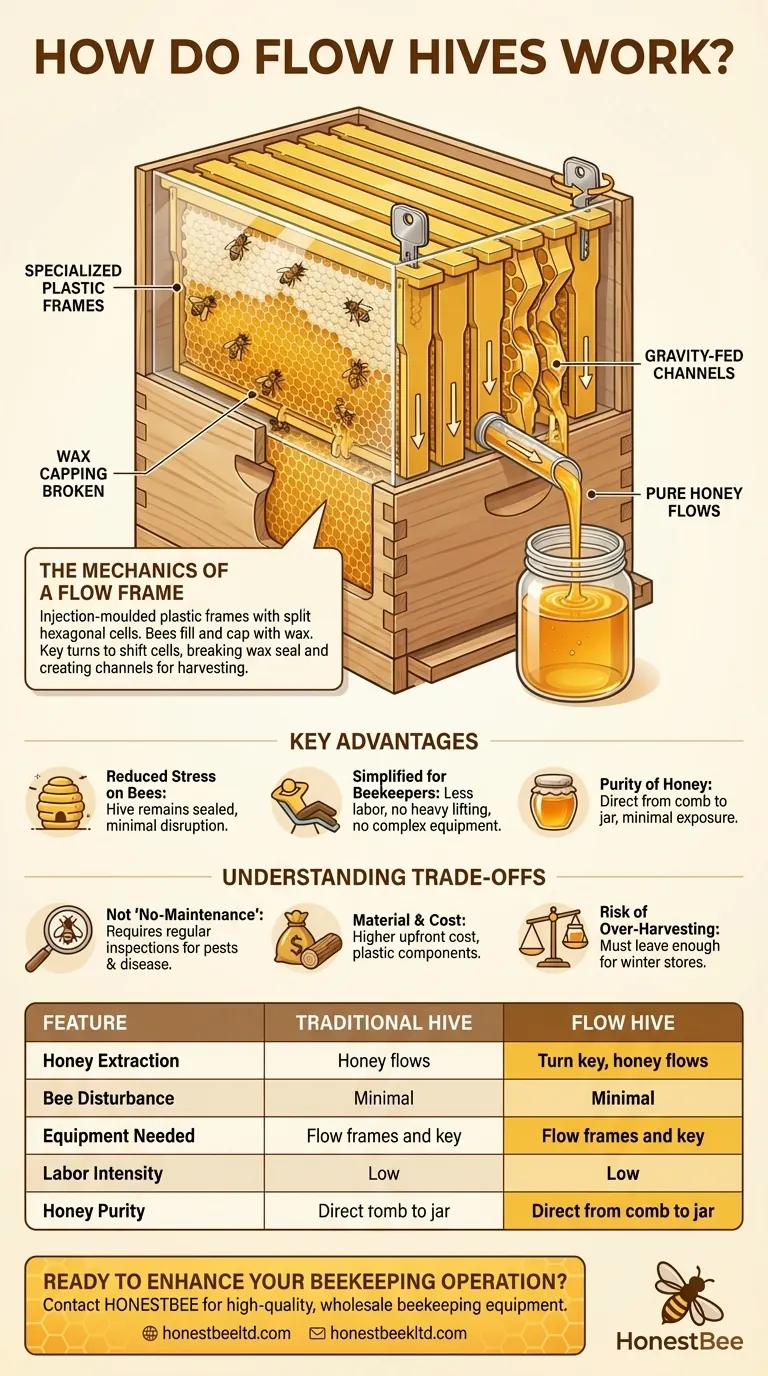
Related Products
- HONESTBEE 6 Frame Three Use Electric Honey Extractor for Beekeeping
- Stainless Steel Triangle Support Honey Strainer and Filters
- HONESTBEE 72 Frame Industrial Electric Honey Extractor for Beekeeping
- Commercial Grade Vertical Electric Bee Sweeper for Bee Removal
- Automatic Honey Frame Uncapper Machine for Beekeeping
People Also Ask
- What type of honey extractor is best? Maximize Your Harvest Efficiency with the Right Choice
- What are the size and power variations in honey extractors? Optimize Your Harvesting Efficiency
- What is a honey extractor and why is it beneficial for beekeepers? Boost Hive Health & Harvest Efficiency
- What is the basic principle of the honey extractor? Harness Centrifugal Force for Efficient Harvesting
- What is the process of using an extractor to harvest honey? Master Efficient, Comb-Preserving Harvests



